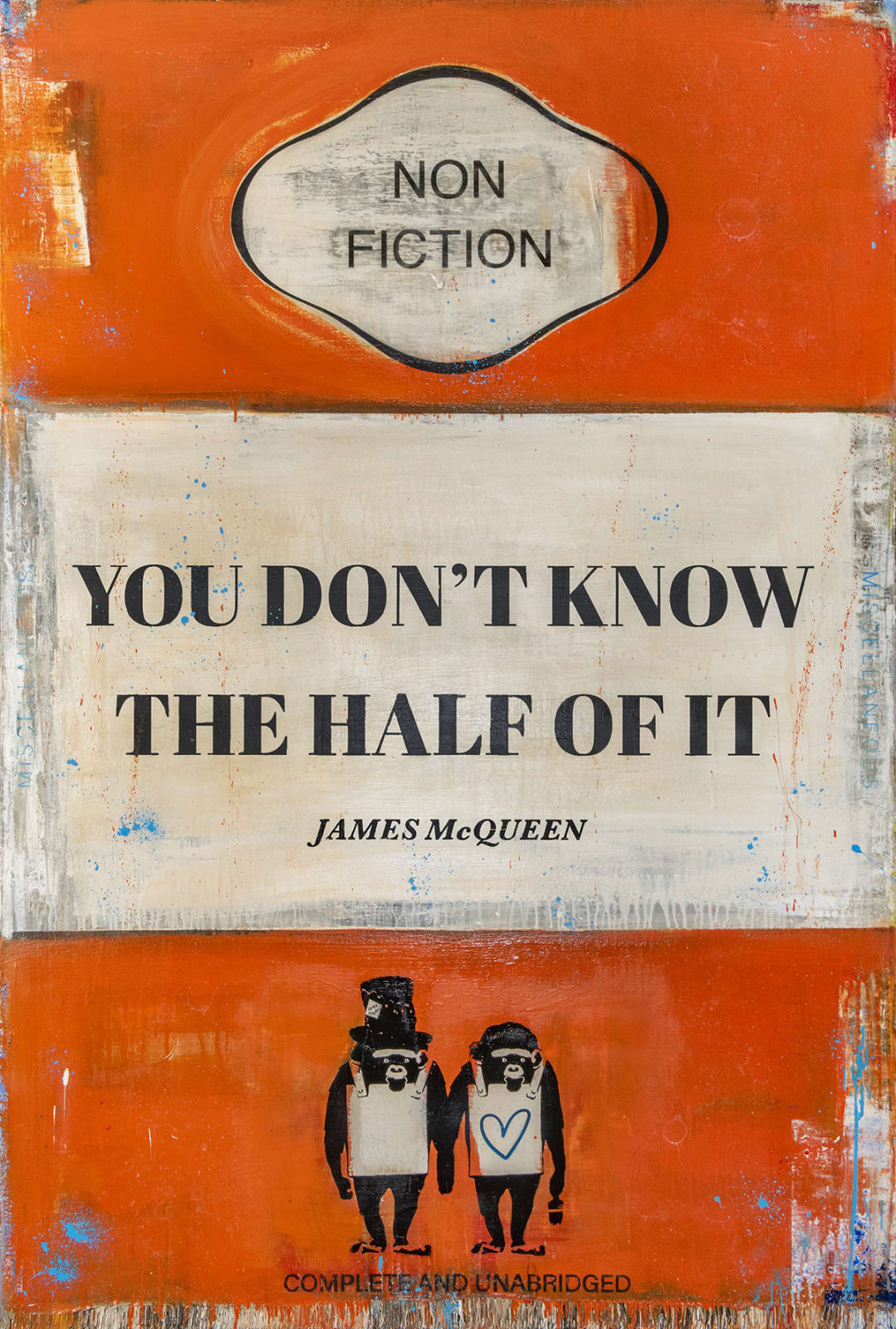James McQueen
James McQueen is a British artist based between London and New York. Operating under a pseudonym, he has created paintings publicly as James McQueen since 2017. He explains: ‘painting under a pseudonym is very important to me. Keeping behind the mask enables me to enjoy the creative process without being concerned about praise or recognition. I enjoy what I do and don’t want that to change or to be changed through judgement. I want my art to speak for itself.’
McQueen’s art is born from his admiration of vintage books. He first became interested in their graphic design through his grandfather who ‘read and had a huge collection of books.’ McQueen explains: ‘He would often read them to me, but I was more interested in the way they looked.’ McQueen began amassing his own collection which totalled over 300 before deciding to develop the cover designs into paintings. From this first painting, McQueen’s career as an artist began to develop organically: ‘I painted one, to begin with, then a neighbour of mine expressed his interest and friends started asking too….it spiralled and grew momentum from there.’
These literary-inspired paintings are rooted in the Pop art of the mid-1950s and 60s. McQueen’s art appropriates the design and branding of an inexpensive, mass-produced and consumed product to echo Andy Warhol’s appropriated imagery in the Campbell’s Soup paintings. Like Warhol, McQueen celebrates the everyday product by making these book covers monumental and vibrant.
While Warhol’s subjects were largely drawn from his own everyday experience, McQueen represents an object that has purely sentimental relevance to him; these books were all published before he was born. For the artist, the age of these objects significantly contributes to their aesthetic appeal and his paintings are symptomatic of this. They convey the illusion of patina, stains, faded colours and tattered edges. McQueen’s intention is to create what he describes as ‘that authenticity‘ of worn-out, vintage books, their charm deriving not from a pristine, glossy finish but a gritty sense of reality. The artist explains that a book which ‘has been passed down has had a life. Where has it been? Where has it travelled? Everyone who owns it has put their little stamp on it, like a tea mark, pencil scribbles, or folded page corners.’ The parallels that can be drawn between an old book and the human experience is not lost on the artist; the book like the individual is changed by time and the people it encounters.

McQueen’s technique is a process of layering the canvas with an abundant application of paint in a number of colours and shades before, once dry, he sands the work down so that a multitude of layers are visible in the finished piece. Finally, the surface is covered with lacquer to add extra richness and vibrancy. Consequently, these paintings are as much about paint and colour as they are about the iconic covers. The visible layering of paint creates a sense of depth and dynamism which, combined with the complex interaction between colours, shares affinities with the Abstract Expressionists and the work of Mark Rothko in particular. McQueen’s artistic methods include the use of spray paint which introduces a contemporary feel to this classic design. In combination with his repeated use of motifs inspired by the graffiti artist Banksy, these paintings contain an urban edge.

The impact of these works is not only visual but conceptual. McQueen communicates a variety of messages through the titles of his paintings and their carefully selected typography. Frequently their tone is provocative, comic and cynical. Often, they are meant to be taken lightly such as HAPPINESS IS EXPENSIVE, which pokes fun at the popular cliché that ‘you can’t buy happiness’. However, others have a more serious point to make. For example, THERE’S NO PLANET-B is a clear statement of activism against climate change. McQueen’s inventive titles place him in dialogue with a tradition of conceptual artists who explore the interaction between bold slogans and abstraction. Like Ed Ruscha, his art investigates the ways in which colour and form affects language. McQueen acknowledges his debt to this conceptual tradition with his painting PROTECT ME FROM WHAT I WANT which appropriated this phrase from the artist Jenny Holzer.
In 2018 McQueen created a series of paintings and screen-prints entitled WHO THE F*** IS BANKSY, in which he replaced the Penguin logo with the iconic rat that frequently features in Banksy’s art. In this painting, the artist mocks himself for having appropriated a motif from another artist. Through such imagery yet another level of irony is achieved; in adopting and combining visual ideas that were invented by other artists, McQueen has created something original.
McQueen’s playful approach continued throughout 2018 and 2019, with a series of canvases that reveal the artist’s taste for harsh comedy, exemplified by REMEMBER WHEN I ASKED YOU FOR YOUR OPINION? ME NEITHER. In YOU SNOOZE YOU LOSE the artist sarcastically references a clichéd, sleazy sales catchphrase; he accentuates its meaning on his social media by repeatedly announcing that this work is sold out. Although humour remains a key feature of his work to this day, 2020 is a year that marked a new function for McQueen’s art as he began to use his paintings as a tool for social and political comment. Initially, this particularly materialised in response to the coronavirus outbreak beginning with LOCKDOWN 2020, citing Dr Anthony Fauci (an early advocate of the implementation of a lockdown in America) as the author. During the first lockdown, McQueen also created a work to raise money for the NHS with the title YOU’LL MISS ME WHEN I’M GONE, a poignant reminder of the possibility that the British health care system could be privatised if it is insufficiently funded.
Through 2021, McQueen continued to respond to what is current, from the international and political to the popular and national such as the release of the new James Bond movie with NO TIME TO DIE and England being in the UEFA European Cup Final with IT’S COMING HOME, referencing the popular England football song Three Lions, first released in 1996.
In the same year, McQueen developed his use of Banksy inspired motifs by adopting the Banksy monkey. NOBODY EVER LISTENED TO ME UNTIL THEY DIDN’T KNOW WHO I WAS includes the monkey in place of the Penguin Books logo, wearing an apron that displays the words ‘F*** the Penguin’. This painting addresses the irony that millions of people are receptive to Banksy’s social and political message, yet his true identity is unknown, in fact, his anonymity seems to have granted him additional authority. Through this painting and others bearing the monkey, McQueen also references the anonymity that he shares with Banksy.
This common anonymity is likely a significant factor that led him to adopt the monkey motif as a kind of insignia. He explains that this decision ‘came about as I wanted a character that I could identify with, something mischievous with a sense of humour that can push boundaries.’ The monkey also wears a hat which McQueen sees as a particularly autobiographical detail: ‘I always wear a hat, even when I paint so, of course, the monkey naturally had to be wearing a hat.’
Many of McQueen’s recent paintings include a second monkey. He explains that he wanted his character to ‘have a partner in crime, much like me and my wife.’ In contrast to the cynical and provocative tone which characterises so many of McQueen’s paintings, these animals hold hands, introducing a touchingly romantic element to his work. This is particularly poignant when combined with the title: IF YOU EVER LEAVE ME I’M COMING WITH YOU.
The body of work that McQueen has produced between 2021 and 2022 is the most expressive and original of his career so far, displaying a greater range of colours, textures and techniques than his earlier work. McQueen’s complex use of paint elevates his art beyond the mere imitation of a nostalgic object towards an art that is rich and expressive.



